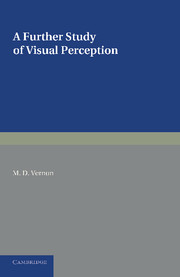Book contents
- Frontmatter
- Contents
- List of Illustrations
- Acknowledgements
- Chapter I INTRODUCTION
- Chapter II THE NATURE OF PERCEPTION
- Chapter III THE PERCEPTUAL PROCESS
- Chapter IV THE DETERMINATION OF FORM
- Chapter V SPATIAL PERCEPTION
- Chapter VI THE CONSTANCIES
- Chapter VII THE FUNCTIONS OF THE FRAMEWORK IN PSYCHO-PHYSICAL EXPERIMENTS
- Chapter VIII THE PERCEPTION OF MOVEMENT
- Chapter IX MICHOTTE'S STUDIES OF SOME INTRINSIC PHENOMENA OF EXPERIENCE
- Chapter X THE INFLUENCE OF INTERNAL AND INDIVIDUAL FACTORS UPON PERCEPTION
- Chapter XI CONCLUSION
- Appendix A
- Appendix B
- References
- Index of Authors
- Index of Subjects
Chapter V - SPATIAL PERCEPTION
Published online by Cambridge University Press: 05 June 2016
- Frontmatter
- Contents
- List of Illustrations
- Acknowledgements
- Chapter I INTRODUCTION
- Chapter II THE NATURE OF PERCEPTION
- Chapter III THE PERCEPTUAL PROCESS
- Chapter IV THE DETERMINATION OF FORM
- Chapter V SPATIAL PERCEPTION
- Chapter VI THE CONSTANCIES
- Chapter VII THE FUNCTIONS OF THE FRAMEWORK IN PSYCHO-PHYSICAL EXPERIMENTS
- Chapter VIII THE PERCEPTION OF MOVEMENT
- Chapter IX MICHOTTE'S STUDIES OF SOME INTRINSIC PHENOMENA OF EXPERIENCE
- Chapter X THE INFLUENCE OF INTERNAL AND INDIVIDUAL FACTORS UPON PERCEPTION
- Chapter XI CONCLUSION
- Appendix A
- Appendix B
- References
- Index of Authors
- Index of Subjects
Summary
THE TWO-DIMENSIONAL FIELD
We have so far confined our discussion to the study of perception of objects and shapes irrespective of the position in which they are situated. It is clear that we not only perceive the relationship of the parts to the ‘wholes’ which they make up; but also of various ‘wholes’ to one another, and particularly to ourselves. In fact, from early childhood we are aware of a three-dimensional spatial continuum of objects, extending away in all directions from ourselves, the centre. Although at any one time we are directly aware only of a small part of this continuum, yet we do not feel that there is any gap in it; we can fill it at any moment by turning our eyes in the appropriate direction. Moreover, the spatial arrangement of objects about us is steady and constant, and when they change their position, this is done in an orderly and recognizable manner. That objects have such a spatial arrangement is indeed inseparably connected with their identity; as Ames (1946a) has pointed out, the ‘thatness’ and ‘thereness’ of concrete objects do not exist as separate entities in their own right. They exist only in relation to one another and to the experiencing organism. We can separate them only by an effort of abstraction.
The distance apart of objects can be assessed with considerable accuracy from (a) their distance apart in the retinal image; (b) the kinaesthetic sensations of movements of the eyes and head made in focusing successive points; (c) the kinaesthetic sensations of movement made in stretching the hands and arms, walking from one point to another, etc. These various sensations are combined and integrated together to form a continuous plan or ‘schema’ of the relative positions and distances apart of objects. There is no discontinuity between the retinal images obtained at successive fixations. The gradual shading off of clearness in peripheral vision ensures that the field of view nowhere comes abruptly to an end. What has just been seen in the extra-foveal region is reproduced and combined with the foveal image into a consciously perceived object with an environmental context, as Auersperg (1939) points out.
- Type
- Chapter
- Information
- A Further Study of Visual Perception , pp. 81 - 118Publisher: Cambridge University PressPrint publication year: 2013



